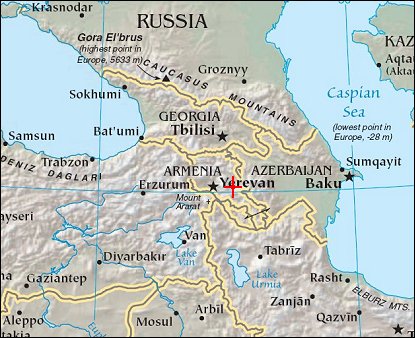| Earth from Space is a free eBook describing our planet from a satellite's perspective. Fore more information, please read the About pages. |

|

Home  Asia Asia  Armenia Armenia  Lake Sevan Lake Sevan |
|






|
|
Lake SevanPosition of center of photo (Lat/Long): [40.38889/45.20702] |
|
  Lake Sevan is the largest lake in Armenia and one of the largest high-altitude lakes in the world. The entire lake is situated inside the eastern Armenian province of Gegharkunik. It is fed by 28 rivers and drained by the Hrazdan (Razdan) river. Only 10% of the outgoing water is drained by the Hrazdan, while the remaining 90% evaporates. Lake Sevan is the largest lake in Armenia and one of the largest high-altitude lakes in the world. The entire lake is situated inside the eastern Armenian province of Gegharkunik. It is fed by 28 rivers and drained by the Hrazdan (Razdan) river. Only 10% of the outgoing water is drained by the Hrazdan, while the remaining 90% evaporates.
In 1910 Soukias Manasserian (one of the civil engineers behind the interventions that caused the Aral Sea disaster) published a study, suggesting to lower the lake to 45 metres and use the water for irrigation and hydroelectricity. In the Stalin era the plan was slightly modified: the water level would be reduced by 55 metres (5 metres more than suggested by Manasserian), the perimeter would shrink to 80 km and the volume to only 5 km3. Nut and oak trees would be planted on newly acquired land, and introducing some trout species into the remainder of the lake would increase fishery production by ten times. The Armenian Supreme Soviet approved the plan without consulting the local people and the major works started in 1933. The river bed of the Hrazdan was deepened and construction of a tunnel 40 metres below the original water level started. The work was delayed due to World War II and was only finished in 1949 when the water level began to fall by more than one metre per year. An ecological disaster like that in the Aral Sea was avoided when the Stalinist era ended in 1956 and the project and its consequences were reviewed thoroughly. As there were troubles with planting oaks and nuts and with fishery, the Sevan committee was established with the mission "to raise the level as much as possible". Hydro-electric power stations on the Hrazdan would be replaced with thermal power stations. In 1962 the level stabilised at 18 metres below the original level, but two years later the lake started to "bloom" due to eutrophic algae. In 1981, a 49 km tunnel was constructed, diverting water from the Arpa river (from a reservoir near Kechut) to the lake near Artsvanist. The water level rose only 1.5 metres, so another 22 km tunnel was begun from Vorotan (further south from Kechut). Only 18 km were constructed before the collapse of the Soviet Union, because in 1988 Azerbaijan imposed an economic blockade on Armenia due to the Nagorno-Karabakh conflict and the work had to be stopped. The Armenian government completed the Vorotan tunnel in 2003, but water has not yet begun to flow into the lake. The level stabilised at 20 metres below the original, and the lake's area is now 940 kmē. Due to recent rain and other changes, the water level is again slowly rising (as of 2005). |
| Source of material: photo by NASA, text partly based on WikiPedia |
Further information: WikiPedia article on Lake Sevan
Last Update: 2011-03-30

